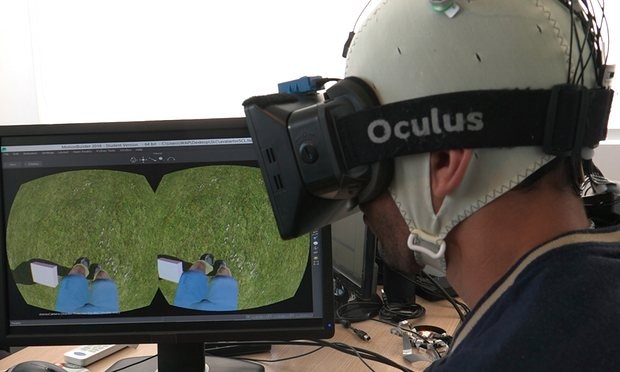Aug 12 2016
 VR technology is combined with harnesses and other walking aids to get the patients accustomed to making a link between movement, and thinking about movement. (Photograph: AASDAP)
VR technology is combined with harnesses and other walking aids to get the patients accustomed to making a link between movement, and thinking about movement. (Photograph: AASDAP)
Neuroscientist Miguel Nicolelis has been inspired by a controversial demonstration at the World Cup in which a paralyzed man wearing a futuristic-looking exoskeleton monitored by his brain kicked a soccer ball.
Based on this demonstration, Nicolelis and his research team are working towards developing something equally impressive and that which will earn global recognition during the 2016 Summer Olympics in his native Brazil.
Nicolelis made his proposal in a recently published study, which revealed that eight Brazilians paralyzed due to spinal cord injuries regained a small though significant muscle control and sensation in their lower limbs after several months of training with the robotic exoskeleton. They were also controlled by brain signals.
All of the eight patients have not benefited from any kind of conventional rehabilitation before the project. They also lacked the potential to control any movement happening below the lower part of the spinal cord injury.
The introduction of virtual reality (VR) technology with off-the-shelf walking devices and overhead harnesses enabled patients to be accustomed to making a connection between movement and thinking about movement.
The sensation of walking was fed back to a pressure pad placed on the forearm of a patient, and a VR avatar was used to provide the patient the illusion of walking. This was followed by providing the unique sensations of walking over mud or grass.
Dr Miguel Nicolelis describes the research Credit: AASDAP and Lente Viva Filmes, São Paulo, Brazil
As the process continued, they started to experience voluntary muscle function below the injury. It started from a complete absence of touch sensation to the capacity to sense vibration, pressure and pain, though not temperature. Improvement in gastrointestinal function was also observed, and improvements in bowel control were experienced by those who spent most of their time upright and walking.
Erections were experienced by the men. All of these participants had been diagnosed as cases of total paralysis, and as an outcome of the training some of the participants have also been reclassified as partially paralyzed.
One study participant was able to conceive and deliver a child, feeling the contractions as she did so, and another was able to leave her house and drive a car. Despite these improvements, none of the eight participants could walk without any assistance.
Some of our patients, for the first time, were able to get out of their houses and go back to work.
Miguel Nicolelis, Duke University
The work is part of the Walk Again Project that unites 100 scientists from 25 countries.
This research featured in Scientific Reports, comes out of the Walk Again Project, which is a huge international research consortium partially financed by the Brazilian government and based in São Paulo. Nicolelis, a celebrity in his home country who had encounters with a few in the Brazilian science community, organized the project.
This project aims to create brain-machine interfaces, which use noninvasive electroencephalogram (EEG) sensors or implanted electrodes to identify brain signals and translate them into commands for prosthesis or various other devices, to the point that allows paralyzed people to operate a motorized exoskeleton, which is a robotic suit that enables keeping the body upright and allowing it to move.
This research corresponds to other approaches to spinal cord injury: there are hopes that electronic implants could bypass a spinal cord injury to send messages from the brain to the muscles, and that stem cell therapy could make room for natural repairs to the nervous system.
Nicolelis, based at Duke University in Durham, North Carolina, refers to the results as “unprecedented” and suggests that a parallel training regimen could one day help a number of people impaired by stroke or those with spinal cord injuries. Other researchers cautiously agree, but highlight that more meaningful recoveries may need an integration of approaches.
The new work is “an advance. I wouldn’t characterize it as a dramatic breakthrough,” says University of Toronto in Canada neurosurgeon Michael Fehlings, who specializes in spinal cord injuries. “The improvements seen are modest. It’s more exciting from a proof of concept standpoint.”
The participants gradually experienced neurological improvements. Some changes were observed after more than six months of training. However, the team confirmed some restoration of sensation and muscle control in all the eight participants only after conducting neurological exams after almost one year.
The team upgraded four complete paralysis patients to partial paralysis. Nicolelis highlights that since then, three of the others also experienced improvements and were eligible for partial paralysis upgrading. Only one patient discontinued training.
Nicolelis further pointed out that his team is producing another publication on the subsequent 18 months of training and the continuous improvements observed by them. “The recovery has not ended,” he says.
Another team reported the use of a brain machine interface that allows a quadriplegic to move his arms and finger, but that system directly operated arm muscles with brain signals identified by implanted electrodes, escaping the injured spinal cord.
The training strategy adopted by Nicolelis is less invasive but would probably be difficult to completely extend to a large number of paralyzed people given the expense of the custom exoskeleton. The two initial stages, the virtual reality and treadmill systems, can be easily used even though it still remains unclear how much recovery they promoted.
Fehlings points out the possibility of integrating brain-machine interfaces with a wide range of treatment strategies, such as drugs and stem cells, in order to provide more benefits for those with injured spinal cords. Fehlings further stated that just one strategy will not help overcome severe paralysis, so “it’s appropriate to be cautious.”